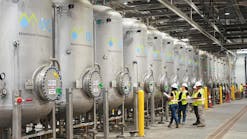Click 'Play' to watch video.
The following is a transcript of the Apr. 23, 2012, edition of the WaterWorld Weekly Newscast.
Hi, I'm Angela Godwin, digital media editor for WaterWorld magazine, bringing you this week's water and wastewater news headlines. Coming up...
• Study finds PVC top performer in pipe
• Collaborative group recognized for water quality efforts
• Enhancing solar disinfection with lime
• Study quantifies Africa groundwater levels
[story1]
A new study of water main breaks from the Buried Structures Laboratory at Utah State University finds that, of all available pipe materials, PVC has the lowest failure rate.
The study, conducted by Dr. Steven Folkman, looked at 188 utilities representing approximately 10% of the nation's installed water main pipe network.
The study also found that corrosion, affecting 75% of utilities, is the second leading cause of water main pipe failure in the U.S.
[story2]
This week, we continue our coverage of the winners of 2012 U.S. Water Prize, a program recognizing innovative, watershed-based approaches to water sustainability.
One of the six recipients is the Salmon Falls Watershed Collaborative, an excellent example of how local, state and federal partners can unite to protect and sustain drinking water supplies.
Paul Susca of the New Hampshire Department of Environmental Services explains.
[soundbite from Paul Susca]
The collaborative has been able to accomplish a number of impressive water quality objectives -- including establishment of LID regulations in Somersworth, NH -- a first in the state.
On April 23, all of the U.S. Water Prize awardees will be recognized at a special ceremony in Washington, DC. Tune into the WaterWorld Weekly newscast over the coming weeks as we will continue to share the winners' stories.
[story3]
Solar water disinfection is one option for purifying drinking water in developing areas where access to clean drinking water is limited or non-existent.
Well now a team of Johns Hopkins researchers have found that adding lime juice can help speed the disinfection process.
Using the SODIS method of solar water disinfection recommended by UNICEF, the researchers found significantly lower levels of E. coli in samples that had either lime juice or lime slurry added, compared those samples undergoing solar disinfection alone.
[story4]
In international news, a group of UK researchers have, for the first time, quantified groundwater resources in Africa.
According to their findings, the total volume of groundwater is around .66 million cubic kilometers -- more than 100 times the amount of available surface freshwater on the continent.
Their results show that in many populated areas in Africa, there is sufficient groundwater to supply hand pumps that communities can use for drinking water.
The researchers said they hope their findings will be used to appropriately site and develop well boreholes across the continent.
For WaterWorld magazine, I'm Angela Godwin. Thanks for watching.
###


